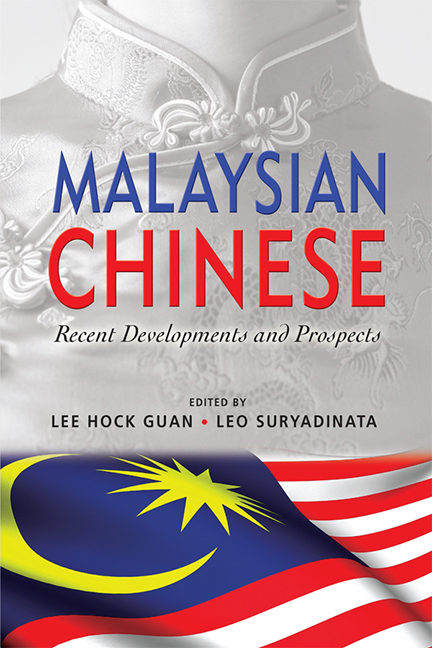Book contents
- Frontmatter
- Contents
- Preface
- Contributors
- Glossary
- Introduction
- 1 Malaysia: Ethnicity, Nationalism, and Nation Building
- 2 Being Muslim and Chinese in Malaysia
- 3 Quo Vadis: The Chinese in Malaysia
- 4 At a Crossroads: Malaysia's Coalition Politics and Chinese-based Political Parties
- 5 The End of Chinese Malaysians’ Political Division? The March 8 Political Tsunami and Chinese Politics in Penang, Selangor, and Perak
- 6 Forced to the Periphery: Recent Chinese Politics in East Malaysia
- 7 The New Malaysian Economic Agenda: Some Preliminary Observations
- 8 The Old And New Malaysian Chinese Language Press, with Special Reference to the 12th General Election
- 9 Education of the Chinese in Malaysia
- Index
9 - Education of the Chinese in Malaysia
Published online by Cambridge University Press: 21 October 2015
- Frontmatter
- Contents
- Preface
- Contributors
- Glossary
- Introduction
- 1 Malaysia: Ethnicity, Nationalism, and Nation Building
- 2 Being Muslim and Chinese in Malaysia
- 3 Quo Vadis: The Chinese in Malaysia
- 4 At a Crossroads: Malaysia's Coalition Politics and Chinese-based Political Parties
- 5 The End of Chinese Malaysians’ Political Division? The March 8 Political Tsunami and Chinese Politics in Penang, Selangor, and Perak
- 6 Forced to the Periphery: Recent Chinese Politics in East Malaysia
- 7 The New Malaysian Economic Agenda: Some Preliminary Observations
- 8 The Old And New Malaysian Chinese Language Press, with Special Reference to the 12th General Election
- 9 Education of the Chinese in Malaysia
- Index
Summary
This chapter will look at the subject of the education of Malaysian Chinese rather than on Chinese education which focuses mainly on mother-tongue education. Two aspects of education which have preoccupied the Chinese community are mother-tongue education and education opportunities. The Chinese are concerned with these two aspects because of the centrality of education to them as a stepping stone to socio-economic success and a means to transmit and preserve their language and culture. During the colonial period, as an immigrant community, the Chinese saw their educational needs largely ignored by the British so they had to mobilize their own resources to establish mother-tongue schools to educate their young. Later, in the post-colonial period their education was subjected to the UMNO-Malay dominated state ambition to create a centralized education system to facilitate the construction of a Malay-centric nation and, after 1970, expand Malay enrolment at the higher education level. As a result, language and education became fiercely contested issues in independent Malaysia where the Chinese community struggled against the UMNO-Malay dominated state to protect and advance their community's education opportunities and mother-tongue education.
In colonial Malaya, there were limited education opportunities in the colony as the British were reluctant to finance an extensive public school system. For the Malays, the colonial state built a small number of Malaymedium schools mainly to teach them their language, culture, and religion, and to be “better” farmers and fishermen (Stevenson 1975). In a number of urban centres, English schools were founded, in part, to supply Englisheducated Malays, Chinese, and Indians to man the colonial service and British businesses. Malay and English schools in effect constituted the colonial “public” school system. While the indigenous Malays were provided with Malay schools, the British regarded the Chinese as foreigners and did not feel morally obliged to provide schools for them. Chinese individuals, groups, and associations thus mobilized to build mother-tongue schools to educate their children and, up to the first two decades of the twentieth century, these schools were largely funded and administered by the community. But, beginning in the 1920s, the colonial state, feeling threatened by the rising nationalism among the Malayan Chinese, tried to offer financial assistance to Chinese schools in exchange for political control; however, few Chinese schools accepted this bargain.
- Type
- Chapter
- Information
- Malaysian ChineseRecent Developments and Prospects, pp. 166 - 192Publisher: ISEAS–Yusof Ishak InstitutePrint publication year: 2011



